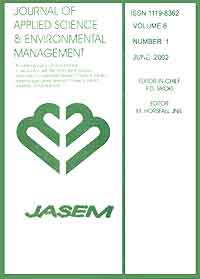
|
Journal of Applied Sciences and Environmental Management
World Bank assisted National Agricultural Research Project (NARP) - University of Port Harcourt
ISSN: 1119-8362
Vol. 22, No. 5, 2018, pp. 647-658
|
 Bioline Code: ja18113
Bioline Code: ja18113
Full paper language: English
Document type: Research Article
Document available free of charge
|
|
|
Journal of Applied Sciences and Environmental Management, Vol. 22, No. 5, 2018, pp. 647-658
| en |
Biosorption of Phosphate Ion on Albizia Lebbeck  Seed Pod with and Without Organic Acid Modification Seed Pod with and Without Organic Acid Modification
ALABI, AH; OLANREWAJU, CA & SUARA, SO
Abstract
This study uses batch experiment to compare the binding efficiency of phosphate onto Albizia
lebbeck (ALB) pod with and without citric acid (CALB) or tartaric acid (TALB) modification. The residual
phosphate concentration was analyzed using ascorbic acid method and the generated data were fitted into equilibrium
isotherms and kinetics models. Intra-particle diffusion model was used to describe the biosorption mechanism.
Characterization by FTIR spectroscopy and SEM shows that modification was successful. The maximum biosorption
capacity occurred at biosorbent dosage of 0.5 g for ALB and 1.0 g for CALB and TALB. At optimum pH for each
biosorbents, phosphate biosorption capacity is in the order ALB>CALB>TALB. Equilibrium time of 90, 150 and
60 minutes were recorded for phosphate on ALB, CALB and TALB respectively. The biosorption capacity increases
as the initial anion concentration increases with highest biosorption capacity of 5.296 mg/g for ALB. Langmuir
isotherm describes CALB data while TALB data fits Freundlich. Results from this study suggest that unmodified
Albizia lebbeck can be used as a low-cost, highly-efficient biosorbent for phosphate removal in effluents.
Keywords
Biosorption; Phosphate; citric acid; tartaric acid; Albizia lebbeck
|
| |
© Copyright 2018 - Alabi et al.
|
|
